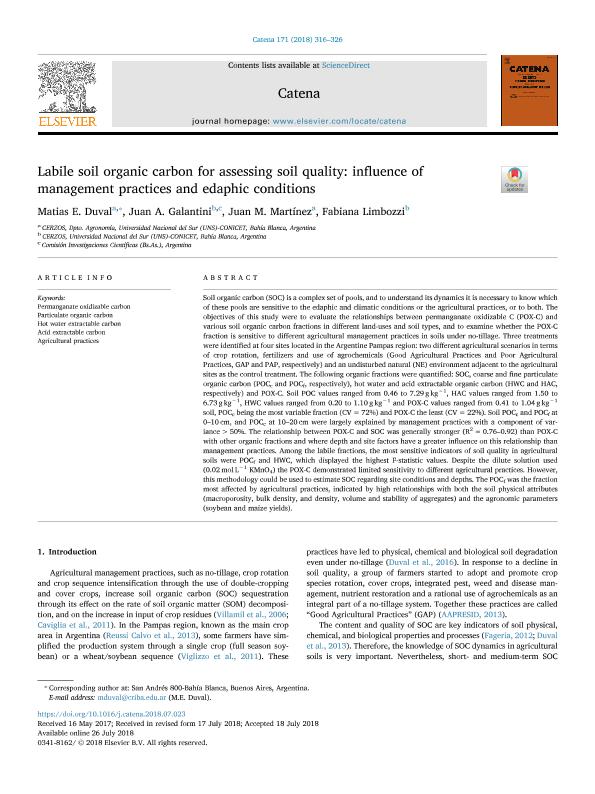Artículo
Labile soil organic carbon for assessing soil quality: influence of management practices and edaphic conditions
Fecha de publicación:
12/2018
Editorial:
Elsevier Science
Revista:
Catena
ISSN:
0341-8162
Idioma:
Inglés
Tipo de recurso:
Artículo publicado
Clasificación temática:
Resumen
Soil organic carbon (SOC) is a complex set of pools, and to understand its dynamics it is necessary to know which of these pools are sensitive to the edaphic and climatic conditions or the agricultural practices, or to both. The objectives of this study were to evaluate the relationships between permanganate oxidizable C (POX-C) and various soil organic carbon fractions in different land-uses and soil types, and to examine whether the POX-C fraction is sensitive to different agricultural management practices in soils under no-tillage. Three treatments were identified at four sites located in the Argentine Pampas region: two different agricultural scenarios in terms of crop rotation, fertilizers and use of agrochemicals (Good Agricultural Practices and Poor Agricultural Practices, GAP and PAP, respectively) and an undisturbed natural (NE) environment adjacent to the agricultural sites as the control treatment. The following organic fractions were quantified: SOC, coarse and fine particulate organic carbon (POCc and POCf, respectively), hot water and acid extractable organic carbon (HWC and HAC, respectively) and POX-C. Soil POC values ranged from 0.46 to 7.29 g kg−1, HAC values ranged from 1.50 to 6.73 g kg−1, HWC values ranged from 0.20 to 1.10 g kg−1 and POX-C values ranged from 0.41 to 1.04 g kg−1 soil, POCc being the most variable fraction (CV = 72%) and POX-C the least (CV = 22%). Soil POCc and POCf at 0–10 cm, and POCc at 10–20 cm were largely explained by management practices with a component of variance >50%. The relationship between POX-C and SOC was generally stronger (R2 = 0.76–0.92) than POX-C with other organic fractions and where depth and site factors have a greater influence on this relationship than management practices. Among the labile fractions, the most sensitive indicators of soil quality in agricultural soils were POCf and HWC, which displayed the highest F-statistic values. Despite the dilute solution used (0.02 mol L−1 KMnO4) the POX-C demonstrated limited sensitivity to different agricultural practices. However, this methodology could be used to estimate SOC regarding site conditions and depths. The POCf was the fraction most affected by agricultural practices, indicated by high relationships with both the soil physical attributes (macroporosity, bulk density, and density, volume and stability of aggregates) and the agronomic parameters (soybean and maize yields).
Archivos asociados
Licencia
Identificadores
Colecciones
Articulos(CERZOS)
Articulos de CENTRO REC.NAT.RENOVABLES DE ZONA SEMIARIDA(I)
Articulos de CENTRO REC.NAT.RENOVABLES DE ZONA SEMIARIDA(I)
Citación
Duval, Matias Ezequiel; Galantini, Juan Alberto; Martinez, Juan Manuel; Limbozzi, Fabiana; Labile soil organic carbon for assessing soil quality: influence of management practices and edaphic conditions; Elsevier Science; Catena; 171; 12-2018; 316-326
Compartir
Altmétricas
Items relacionados
Mostrando titulos relacionados por título, autor y tema.
-
Zhang, Chuanlun; Shi, Tuo; Liu, Jihua; He, Zhili; Thomas, Helmuth; Dong, Hailiang; Rinkevich, Buki; Wang, Yuze; Hyun, Jung-Ho; Weinbauer, Markus; López Abbate, María Celeste ; Tu, Qichao; Xie, Shucheng; Yamashita, Youhei; Tishchenko, Pavel; Chen, Quanrui; Zhang, Rui; Jiao, Nianzhi (Elsevier B.V., 2022-12-31)
-
Ballarini, Adriana Daniela ; Bocanegra, Sonia Alejandra ; Mendez Moreno, Jonathan Eduardo ; de Miguel, Sergio Ruben ; Zgolicz, Patricia Daniela (Elsevier Science, 2022-08)




